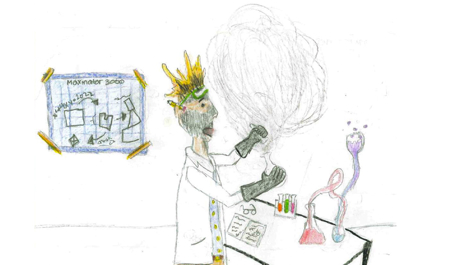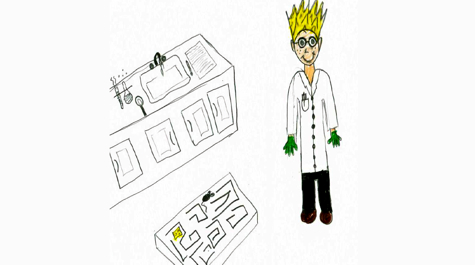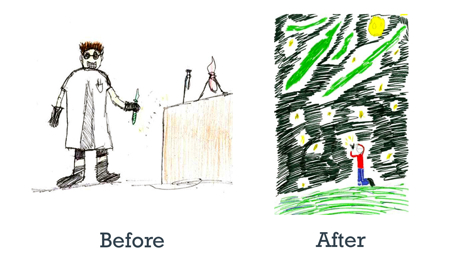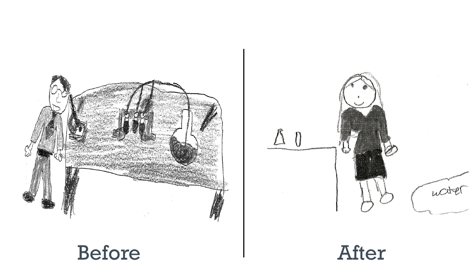VIMS grad students help kids expand perception of scientists
Children are natural scientists, frequently asking questions about the world around them and how it works. But ask a child to draw a picture of a scientist, and they will most often sketch someone who looks nothing like themselves—an older white male with unkempt hair and a lab coat, holding a beaker in his hand and pens in his pocket.
This narrow perception concerns educators and scientists worried about the future work force, based on studies showing that children and teens are more likely to pursue careers that provide role models with whom they can identify. During the next 10 years, fully two thirds of the fastest-growing occupations are expected to be in the fields of science, technology, engineering, and mathematics.
Graduate students at the Virginia Institute of Marine Science are now helping students in local middle schools and high schools to draw—literally—more accurate and positive conclusions about what scientists look like and do.
The grad students are fellows in the VIMS GK-12 PERFECT program, a 5-year partnership with middle- and high-school teachers and students at 4 local schools.
Draw a Scientist
At the beginning of the school year in 2009, a trio of PERFECT fellows—Lindsey Kraatz, Heidi Geisz, and Erica Holloman—asked the pupils in their classes to draw a scientist. They also asked the pupils to describe their drawing in words, to list 3 words that come to mind when they look at their scientist, and to describe what their scientist does on a typical day.
The results were telling. Common adjectives were smart, crazy, chemicals, mixing, nerd, weird, lab coat, old, lab work, hard-working, and cool. The 6 classes that were tested depicted male scientists in 50% to 80% of their drawings. The highest percentage of female scientists drawn by a class was 30%, with the percentage in other classes ranging from less than 5 to about 15. Overall, the ratio of males to females in the drawings was 5 to 1.
By comparison, 30% of the faculty at VIMS is female, as are 62% of VIMS’ graduate students. Many scientists at VIMS spend as much time in the field as they do in a lab, and very few carry pens in their shirt pockets or wear pocket protectors. Most comb their hair at least occasionally.
A PERFECT solution
The PERFECT program—for Partnership between Educators and Researchers for Enhancing Classroom Teaching—connects selected VIMS grad student fellows with teachers and pupils at Booker T. Washington Middle School in Newport News, Chesapeake Bay Governor’s School in Glenns (Rappahannock Community College), Page Middle School in Gloucester, and York High School in Yorktown. The schools serve diverse populations, from urban to rural, and with the number of ethnic minorities ranging from 11 to 50 percent.
The program is the brainchild of VIMS professor Kam Tang, Graduate Dean Iris Anderson, and Virginia Sea Grant educator Vicki Clark. Tang says a key goal of the 5-year program, which is funded by the National Science Foundation, is “to bring real-life scientists into classrooms in order to improve the K-12 curriculum and stimulate interest in science.”
Grad student Lindsey Kraatz, the driving force behind the “Draw a Scientist” project, wanted to know whether that goal was realistic—whether students would gain more interest in science and a more positive attitude toward science and scientists by interacting with real scientists in the classroom.
To test her idea, Kraatz asked Geisz and Holloman to join her in the Draw a Scientist exercise, comparing their students’ initial drawings and descriptions with drawings and descriptions done at the end of the first semester. They compared the before and after drawings and verbal responses to see how the students’ perceptions of scientists and science may have changed after several months in a classroom with a practicing scientist.
Kraatz is using remote-sensing techniques to study sediment transport in the York River. Geisz is studying the accumulation of persistent organic pollutants in Antarctic seabirds. Holloman is studying the consumption patterns of mercury in seafood by members of the local African-American community.
Encouraging results
Kraatz says the results of the first year of the experiment were encouraging. She says “The students in our classes came to see that science was not as overwhelming as they initially thought, and they became less apprehensive of science concepts and scientists.”
Kraatz notes that the “after” drawings tended to show scientists in less traditional settings, such as in the water with SCUBA, and without stereotypical scientific equipment like lab coats or beakers.
The adjectives the students used to describe their scientist changed as well, with words such as weird, lab coat, old, and lab work dropping away, to be replaced by words such as nice, experiment, chemicals, and fun. Use of “nerd” dropped from 19% in the “before” descriptions, to 5% afterwards. In general, positive words like “cool” and “fun” became more common, while use of negative terms like “mad” and “stupid” decreased.
Student perception of the scientists’ gender also changed during the study, with more drawings of female scientists. Overall, the drawings’ male to female ratio dropped from 5 to 1 to 2 to 1.
Kraatz says the most important change she saw was that the students’ “expanded their perceptions of what a scientist is or can be.” She was particularly encouraged by “after” drawings in which the students drew themselves as the scientist.
Encouraged by the results of last year’s preliminary study, Kraatz is expanding and refining the Draw a Scientist experiment this year, involving all but one of the 8 PERFECT fellows enrolled in the 2010-2011 program. In addition to Kraatz, this year’s fellows are Sam Lake (Yorktown High School), Daniel Maxey and Stephanie Salisbury (Booker T. Washington Middle School), Matt Whalen and Lara Gates (Page Middle School), and Candace Spier (Chesapeake Bay Governor’s School). The remaining fellow, Noelle Relles at CBGS, is not participating because she has the same students as last year.






